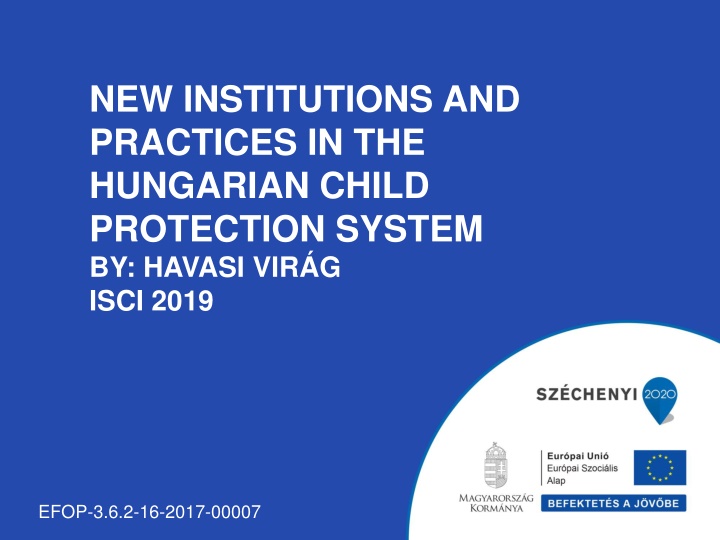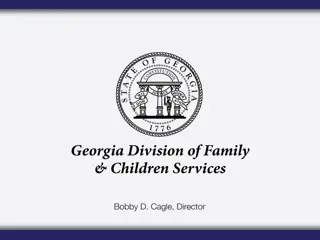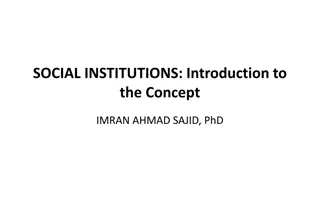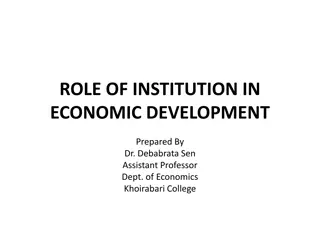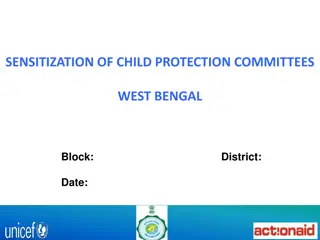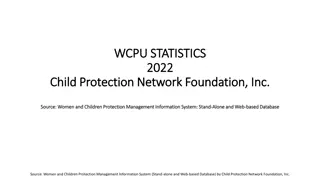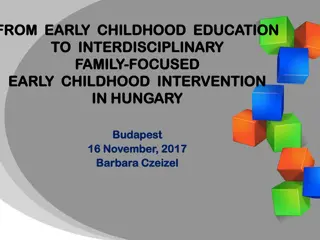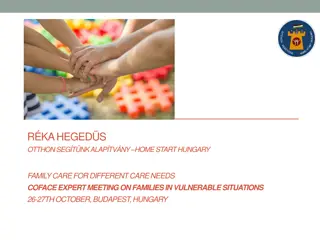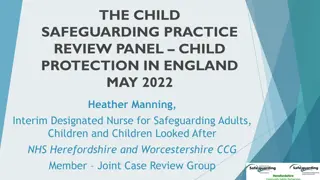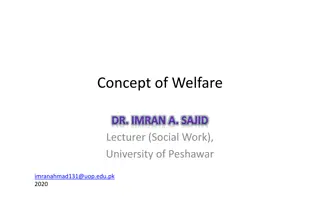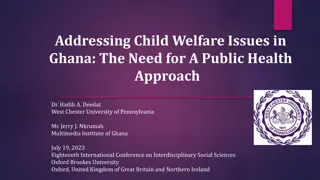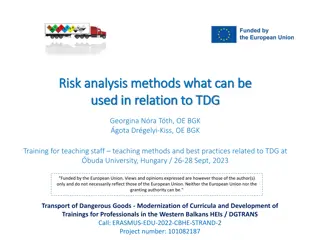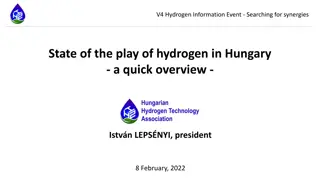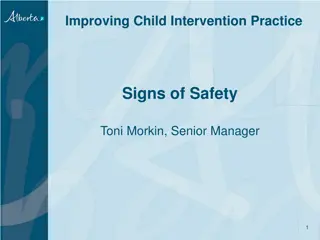Child Protection System in Hungary: New Institutions and Practices
The situation of children in Hungary, especially Gypsy children, sheds light on the challenges and disparities in child protection and welfare. The Hungarian child protection system addresses issues of abuse, neglect, and poverty among children, but faces hurdles in providing equal opportunities and support. The structure of the system includes financial aids, social services, and administrative measures to safeguard children at risk. Efforts are also made to combat slums and improve the overall well-being of Hungarian children.
Download Presentation

Please find below an Image/Link to download the presentation.
The content on the website is provided AS IS for your information and personal use only. It may not be sold, licensed, or shared on other websites without obtaining consent from the author.If you encounter any issues during the download, it is possible that the publisher has removed the file from their server.
You are allowed to download the files provided on this website for personal or commercial use, subject to the condition that they are used lawfully. All files are the property of their respective owners.
The content on the website is provided AS IS for your information and personal use only. It may not be sold, licensed, or shared on other websites without obtaining consent from the author.
E N D
Presentation Transcript
NEW INSTITUTIONS AND PRACTICES IN THE HUNGARIAN CHILD PROTECTION SYSTEM BY: HAVASI VIR G ISCI 2019 EFOP-3.6.2-16-2017-00007
SITUATION OF CHILDREN IN HUNGARY Hungarian population: 9, 798, 000 (2017) 1, 694, 396 children (age 0-14) (census, 2011) 19.2% of children( 400,000) were living in severe material deprivation (KSH 2019) the category of children who live permanently on the streets is virtually nonexistent, with the exception of addicted youngsters and immigrant children (some beggar families from Romania)
SITUATION OF GYPSY CHILDREN the number of the Gypsies: 876 000, credible estimates 13% of children s population is Romani less than half but more than a third of the Hungarian Gypsies lives in deep poverty and the same is true for the rate of Gypsies among the extremely poor people three quarters of the Gypsies lives at risk of poverty and social exclusion 55.5% of Gypsy children are living in severe material deprivation Residential and school segregation (In 15% of schools the percentage of Gypsy children was over 40%, in 10% of schools it was more than 50%. There were 52 schools where 90% of the students were Gypsy and in 34 schools it was 95%. The competency results showed that when the proportion of Gypsy students rose above 10% the average school performance began to decrease) Early school leaving, low educational level (6.97% of Gypsy children do not finish primary school, 4.39% do not enroll in secondary or VET school, 42.35% drop out of secondary or VET schools, 24.69% obtain vocational school qualifications, 21.59% pass leaving exams and complete secondary school, 4.21% start higher education)
CHILDREN IN THE CHILD PROTECTION SYSTEM (2011) Abused and neglected children Minors of risk registered for reasons of Physically abuse 3 127 Psychically abuse 5 499 Sexually abuse 374 Total abuse 9 000 Physically neglect 12 362 Psychically neglect 9 741 Total neglect 22 103 Environment (47 151) Behaviour (51 041) Means (92 146) Health (7 610)
THE STRUCTURE OF THE CHILD PROTECTION SYSTEM Financial supports, benefits in-kind (e.g. regular child benefits, free or cheap meals in educational institutions, free course books, after-care provision) Basic social services Professional social services Administrative measures (placement under protection, taking the child out of its family and acceptance of the child in another family (csal dba fogad s), temporary placement (ideiglenes hat ly elhelyez s), foster care (nevel sbe v tel), adoption)
BASIC SERVICES Basic care level s aims: preventing child endangerment and facilitating the bringing-up of children in families family and child welfare services in settlements, family and child welfare centres in districts financial support and benefits-in-kind, child welfare service: individual case management of the endangered child, family in-team work aimed at eliminating the endangering factors, and the provision of services aimed at meeting the children s daily needs, or the full or partial takeover of the child s care on a temporary basis (voluntary) day-time care of children and temporary care of children, parents can request to get their children back at any point parental rights of supervision are not affected at this time, Placement of children with substitute parents/ in Children s temporary home (1200 children)/ temporary home for families (6200 children) (for a maximum of 12 months) Creche, alternative daytime programs, study halls, sure start children s houses Indication system
PROFESSIONAL CHILD PROTECTION SERVICES home-like provisions: children s homes, foster parents, apartment home After care county professional child protection services (tgysz)
PROBLEMS 1 Underfunding Low salary labour shortage in the social sphere, overload Lack of professional knowledge (complex knowledge would be necessary, professional training after graduation is compulsory but costly) Burn-out (supervision: missing or not compulsory and many social workers do not participate) Not enough means in the hands of the social workers Preventive social care and community development in Hungary are underdeveloped (but SSCH, SH) Organization of alternative daytime and holiday programs: has only a legal definition, but the Goverment does not provide sources per capita, it has been granted only by NGOs
PROBLEMS 2 the broad definition of endangerment and its application which results in children being removed from their families for material reasons, though this is banned by law ( territorial differences in the country- Romani children appear to be removed more frequently from their families for material reasons than non-Romani children) The chance for children taken out of their family to go back to their own family is low Dilemmas of Chilren s home, apartment homes, foster parents Long time in temporary placement Gypsy children are overrepresented in the system, Regarding identity questions there are challenges in the system: identity crisis because they grow up with a weak sense of ethnic identity in the absence of their parental or community influence and input, and may even experience rejection by this community, although they will also most likely be treated as a member of the Romani community by non-Roma
PROBLEMS 3 (ADOPTION) the majority of adoptive parents are non-Romani adults who are unwilling to adopt Romani children for reasons ranging from anti-Romani attitudes, to a lack of preparation to take on a Romani child, to pressure from the surrounding environment, to fear of being incapable of raising a Romani child potential adopters reportedly refuse en masse to adopt children with disabilities Romani children are more likely than non-Romani children to be labelled with a mental disability or special learning need they are at a double disadvantage regarding the identification of suitable adoptive families In 2017 21 000 children received special care, 1972 of them were adoptable and 1025 were adopted (234 to abroad)
SURE START CHILDRENS HOUSE SSCHs: - provide children with meals and skill development activities on a daily basis and survey their conditions regularly, - provide parents with the possibility of participation in activities together with their children, special personality and capacity development and other preventive programmes, - organise community events
SSCH The idea and methodology were developed and tested in the UK The Hungarian adaptation of the programme began in 2003 (first with EU funds, now partly from domestic resources) Now 265 SSCHs are functioning (3155 settlements in HU) Since 2018 Child protection act Problems (not enough, lack of professionals, not exploited, the poorest people do not use)
TANODA STUDY HALL Study halls are: providing a learning space for disadvantaged pupils; identifying and supporting gifted children; reducing early school leaving, grade repetition and unemployment providing extra-curricular activities for disadvantaged young people; improving cultural life; developing social skills for employment; offering guidance After school Run by NGOs and churches
SH The first study hall was opened in a disadvantaged district of Budapest (J zsefv rosi Tanoda) in 1995 After 2004 study halls were established with the support of EU funds In 2018 Study halls have become incorporated into the child protection act and the means of domestic financing is being formulated just now 274 study halls were functioning in 2018 Problems (rent seekers, not enough, conservative teaching methods in some places)
CONCLUSIONS Good ideas in underfunded system, lacking quality control (expenditure on social protection in HU 19,1% of GDP in 2016, while EU 28 average was 28,1% On child protection HU spends 2,3% of its GDP)
KSZNETNYILVNTS A kutat st az EFOP-3.6.2-16-2017-00007 azonos t sz m , Az intelligens, fenntarthat s inkluz v t rsadalom fejleszt s nek aspektusai: t rsadalmi, technol giai, innov ci s h l zatok a foglalkoztat sban s a digit lis gazdas gban c m projekt t mogatta. A projekt az Eur pai Uni t mogat s val, az Eur pai Szoci lis Alap s Magyarorsz g k lts gvet se t rsfinansz roz s ban val sul meg.
